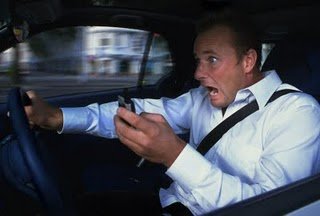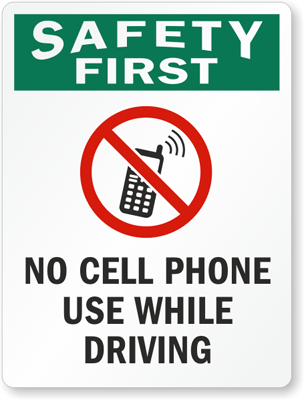Introduction
Vehicle accidents occur when a car collides with another car, pedestrian, or animal. A vehicle may also veer of the road and hit some stationary object such as a tree or pole or reaches a rough terrain such as a steep slope. Traffic accidents cause injury and death to millions of persons around the world.
Other results of accidents include loss of property. The dictionary defines an accident as an unforeseen and unwanted event or a disaster that occurs without any warning. However, strictly speaking, a number of traffic ‘accidents’ do not qualify as accidents since they could have been avoided.
Vehicle accidents are caused by a vast number of factors and the top six causes are in order from most common to least: distracted drivers, driver fatigue, drunk driving, speeding, aggressive driving, and weather.
Distracted Drivers
There are three main forms of distraction among drivers: visual, manual, and cognitive. Visual distraction occurs when a driver takes his eyes of the road while manual distraction occurs when a driver takes his hands off the steering wheel and finally, cognitive distraction occurs when a driver takes his concentration off the road. Research has shown that distracted drivers are the leading cause of car accidents(Redelmeier & Tibshirani, 1997).
Distractions are caused by a number of activities, however, a significant number of distractions have been attributed to mobile phone use. For instance, a driver may receive a phone call or make one, and while tending to the call, takes his mind of the road and increasing the chances of causing an accident. Writing text messages also cause distractions as a driver takes both his eyes and mind of the road (Strayer et al, 2003).

Figure 1: Distracted Driver
Other forms of distraction among drivers that have been numerously cited include low-tech distractions such as spilling hot coffee on oneself or dropping something on the floor and changing a radio station or tuning a climate control gadget.
A second, commonly reported cause of road accidents is driver fatigue. This condition is created when a driver suffers from the symptoms of fatigue while driving as a result of inadequate sleep and rest. Driver fatigue causes many drivers to fall asleep while on the wheel and this regularly leads to road accidents, however, it may also lead to exhaustion, causing a driver to make serious- and deadly- traffic mistakes (Redelmeier & Tibshirani, 1997).
Driving under the influence of alcohol, or drunk driving, is a leading cause of road accidents among the youth. Accidents arising from drunk driving normally occur during the weekends or on major holidays. Alcohol-related deaths are so common in the US, close to 40 % of all adult persons in the US will have been involved in a road accident involving alcohol. Over-speeding among drivers, aggressive driving, and poor weather make up the rest of the road accidents that occur in the US (NHTSA, 2010).
Phone Use and Road Accidents
Mobile phone use while driving is a very common phenomenon and can be quite dangerous. Indeed, several studies have shown that the number of deaths arising from phone use while driving has been increasingly steadily, and that drivers who use mobile phones while driving are at a higher risk of being involved in a road accident that those who do not (Strayer & William, 2001).
The U.S. National Highway Traffic Safety Administration (NHTSA) recently released the results of a study that focused on the number of deaths resulting from driver distractions for the tear 2009 (NHTSA, 2010).
From the report, there were 5,474 fatalities arising from distracted drivers. Out of these fatalities, 995 were as a result of distraction by mobile phones. However, the report did not indicate whether there was a positive association between cell phone use and accidents (NHTSA, 2010).

Figure 2: Phone use and Road Accidents
A study of car accidents in the US conducted in 2003 showed that driver inattention resulted into 20-50 per cent of all road accidents (Eby and Lidia, 2003).
Driver distraction, which is a branch of inattention, has been approximated to be a causal factor in between 8 and 13 per cent of all accidents. Under driver distraction, mobile phone use contributes to between 1.5 and 5 per cent. However, the large number of variables in road accidents may cause errors in getting a clear picture of the overall contribution of cell phones to all road accidents.
These are variables that may also contribute to road accidents and include poor weather, poor roads, mechanical problems, driver fatigue, over speeding, and so on. The NHTSA recognizes this and asserts that only a small proportion of accidents are reported as having being caused by cell phone distraction. Inadequate reporting and use of different analytical techniques has led to differing results in various studies.
A report published by the Human Factors Journal reveals that cell phone use among drivers cause between 2,600 deaths and 330,000 deaths annually (Horrey and Christopher, 2006). Because of the rising number of deaths attributed to mobile phone use while driving, several states have passed legislation that limits cell phone use while driving on busy roads and highways.
Legislation

Figure 3: Legislation
Although restrictions have long been in place, they have been enforced by including strict penalties to stem the increase in the number of drivers ignoring the traffic rules. Some of the US states that have enacted laws against phone use while driving include California, Oregon, Connecticut, New Jersey, New York, and Washington.
Most of the states have placed bans on all forms of hand held cell phone use while driving. As a result, a traffic officer can ticket a driver for using handheld mobile phones without any other offence having taken place (McEvoy et al, 2005).
As of January 2008, the state of Oregon enacted a law that stated that persons below the age of 18 years are not allowed to “operate a motor vehicle while using a mobile communication device” (Oregon.gov, 2011).
Additionally, such persons must have one of the following: 1) a permit; 2) a temporary driving license; or 3) a special student driver permit. A mobile communication device is described as “a text messaging device or a wireless, two-way communication device designed to receive and transmit voice or text communication” (Oregon.gov, 2011).
Persons convicted of this offence must undergo the Provisional Driver Improvement Program among other forms of punishments. And on the other side of the nation, the state of Tennessee does not authorize any learner permit or person holding a temporary license from using a mobile phone while driving. Besides, it is an offence for anyone to read or write a text message while driving. These laws are extended to school bus drivers, unless there is an emergency.
Several countries in the world have implemented strict laws on cell phone use while driving. For instance, in 2007, UK enacted traffic laws in which a traffic officer could add three penalty points to driver’s licenses besides a fine for motorists caught violating this law. Israel, Japan, and Singapore all ban mobile phone communication, as well as hands-free devices. New Zealand enacted laws against hand held devices in 2009.
A number of countries have adopted these laws in part or in full. Some countries use the legislation selectively on different segments of the population; stricter measures are placed on younger drivers.
Canada, Austria, Australia, Brazil, Israel, Italy, China, Ireland, Turkey, UK, Spain, Kenya, Malaysia, Morocco, and Bulgaria are just a few of the countries that have placed some form of ban on handheld cell phone use by motorists. Countries such as Japan and some states in the US have banned both handheld and hands-free communication devices.
Cell Phone Use while Driving is Dangerous
(Argument 1) When a driver uses the phone while driving, his eyes are not fixed on the road due to distraction from the conversation. A Ford study showed that there is a considerable difference in the distraction level between voice-controlled systems such and visually and manually operated systems mobile phones (Ford, 2011).
Further studies by the Human Factors and Ergonomics Society showed that cell phone use causes drivers to respond slower to brake lights (Horrey and Christopher, 2006). In a minor positive finding, they were found to keep a 12% per cent breaking distance.
However, drivers were found to take 17 per cent more time to regain their speed when they braked, an action that frustrates everyone as it slows down the overall flow of traffic and increases the likelihood of an accident. Although some people have mentioned that using hands-free cell phone eliminates driver distraction, similar studies have proved the opposite; hands-free cell phones distract drivers as much as non-hands free units (Strayer & William, 2001).
Scientists have found out that while using hands-free systems, drivers ‘look but they do not see’ as their mind is diverted onto the phone call. Besides, the use of mobile phones for long hours has been found to be harmful as it can lead to brain cancer.
(Argument 2) The Journal of the Human Factors and Ergonomics Society reports that using a cell phone while driving is just as risky as driving under the influence of alcohol (Horrey and Christopher, 2006). A paper by Strayer et al reported that the level of distraction caused by the two factors is similar (Strayer et al, 2003).
Of importance is that the study did not spare hands free devices, asserting both handheld and hands-free cell phones have similar effects on driver distraction. Since the use of mobile phones while driving is as bad as driving, the drivers must completely abstain from using them.
(Argument 3) Although many authorities have advised drivers to use hands-free cell phones rather than those that are handheld, studies have the latter is not significantly secure than the former. The study, undertaken by the AAA, indicates that hands free kits can cause enough distraction to cause a road accident (AAA, 2001) These studies found out that using hands free kits causes an increased ‘cognitive workload’ due to the involvement in conversation.
This distraction can lead to a 37 per cent drop in cognitive activity in the brain. Hence, the distracting factor is the conversation and not the device. Consequently, there has been a call for the ban of both hands free and handheld mobile devices by drivers, especially learners. However, a complete ban on the use of all mobile phone devices while on the road is the surest way of eliminating all accidents related to cell phone use (Utah DUI Checkpoints, 2009)
(Counter Argument 1) One weakness of the call to ban the use of cell phones by motorists is that such a move would imply that we ban all communication devices, a deed that is practically impossible due to the vast benefits of communication.
Cell phones help individuals to interact effortlessly over long distances and their full ban would create an inconvenience to a very large number of people. In fact, it is common that a driver asks for turn-by-turn instructions when driving into a new place. Instead of banning these devices, drivers should be advised on ways through which they can reduce road accidents and still use their phones. However, if such a move would benefit society against all the consequences, then we should proceed with the move.
(Counter Argument 2) The second counter argument against a ban on cell phone use while driving is that such a move might induce a state of boredom and cause a driver’s mind to wander off the road. Boredom might also induce dizziness or sleepiness. A sleepy driver may try to avoid sleep by talking to their spouse or friend (AAA, 2001). Instead of banning cell phone use, some factors and considerations should be assessed. These include:
- Is the driver using headphones or not?
- What is the nature of the conversation? Is it casual or heated?
- The pace of the drive and the weather condition;
- The experience of the driver; and so on.
These factors must be considered in coming up with security measurements, and it must be recognized that a sleepy driver on the road poses a far higher risk that one using a cell phone.
(Rebuttal Counter Argument 1 and 2) While authorities place bans on cell phone use by drivers, it is vital to note that individuals have every right to use their mobile devices as long as they do not violate the social requirement of keeping other road users safe. However, drivers also have a role to play in minimizing these risks, for instance, they can engage in other activities that prevent boredom and yet keep them alert on the road, such as listening to music through the car stereo.
Conclusion
Road accidents arising due to the use of mobile phones by driers have been on the rise in the past few decades. In most countries, the number of accidents has been proportional to the number of mobile phone subscribers thereby pointing to a positive link between the two.
These accidents are caused as a result of distractions among drivers. To reduce their occurrence, drivers must keep their eyes and minds on the road by limiting mobile phone use, both handheld and hands free. Failure to concentrate fully on the road can lead to serious injuries and even death of one or a couple of people. In order to improve the safety of our roads, each of us must play a role towards this goal.
References
AAA Foundation for Traffic Safety. (2001). The Role of Driver Distraction in Traffic Crashes. Web.
Eby, D., and Lidia K. (2003). Driver distraction and crashes: An assessment of crash databases and review of the literature. Michigan: UMTRI.
Ford. (2011). Study: Ford Sync Reduces Driving Distractions, Helps Drivers Keep Eyes on Road. Web.
Horrey, W. and Christopher W. (2006). Examining the Impact of Cell Phone Conversations on Driving Using Meta-Analytic Techniques. Human Factors (Human Factors and Ergonomics Society), 38 (1): 196–205.
McEvoy, S. Stevenson, M. R., McCartt, A. T., Woodward, M., Haworth, C., Palamara, P., and Cercarelli, R. (2005). Role of mobile phones in motor vehicle crashes resulting in hospital attendance: a case-crossover study. BMJ, 331 (7514): 428.
NHTSA. (U.S. National Highway Traffic Safety Administration). (2010). Distracted Driving 2009. Traffic Safety Facts.
Oregon. (2011). Oregon law prohibits use of cell phones and text messaging by teen drivers. Web.
Redelmeier, D. Tibshirani, R. (1997). Association between Cellular-Telephone Calls and Motor Vehicle Collisions. The New England Journal of Medicine, 336 (7): 453–458.
Strayer D. L. & William J. A. (2001). Driven to distraction: Dual-Task Studies of Simulated Driving and Conversing on a Cellular Telephone. Psychological Science, 6 (12): 462–466.
Strayer D. L., Drews F. A., & Johnston W. A. (2003). Cell Phone-Induced Failures of Visual Attention During Simulated Driving. Journal of Experimental Psychology, 1 (9): 23–32.
Utah DUI Checkpoints. (2011). Banning Texting While Driving Will Save Lives. Web.
Figure 1 and 2: Web.
Figure 3: Web.